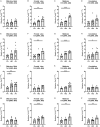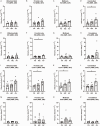Aspergillus versicolor Inhalation Triggers Neuroimmune, Glial, and Neuropeptide Transcriptional Changes
- PMID: 34098774
- PMCID: PMC8191080
- DOI: 10.1177/17590914211019886
Aspergillus versicolor Inhalation Triggers Neuroimmune, Glial, and Neuropeptide Transcriptional Changes
Abstract
Increasing evidence associates indoor fungal exposure with deleterious central nervous system (CNS) health, such as cognitive and emotional deficits in children and adults, but the specific mechanisms by which it might impact the brain are poorly understood. Mice were exposed to filtered air, heat-inactivated Aspergillus versicolor (3 × 105 spores), or viable A. versicolor (3 × 105 spores) via nose-only inhalation exposure 2 times per week for 1, 2, or 4 weeks. Analysis of cortex, midbrain, olfactory bulb, and cerebellum tissue from mice exposed to viable A. versicolor spores for 1, 2, and 4 weeks revealed significantly elevated pro-inflammatory (Tnf and Il1b) and glial activity (Gdnf and Cxc3r1) gene expression in several brain regions when compared to filtered air control, with the most consistent and pronounced neuroimmune response 48H following the 4-week exposure in the midbrain and frontal lobe. Bulk RNA-seq analysis of the midbrain tissue confirmed that 4 weeks of A. versicolor exposure resulted in significant transcriptional enrichment of several biological pathways compared to the filtered air control, including neuroinflammation, glial cell activation, and regulation of postsynaptic organization. Upregulation of Drd1, Penk, and Pdyn mRNA expression was confirmed in the 4-week A. versicolor exposed midbrain tissue, highlighting that gene expression important for neurotransmission was affected by repeated A. versicolor inhalation exposure. Taken together, these findings indicate that the brain can detect and respond to A. versicolor inhalation exposure with changes in neuroimmune and neurotransmission gene expression, providing much needed insight into how inhaled fungal exposures can affect CNS responses and regulate neuroimmune homeostasis.
Keywords: Aspergillus versicolor; RNA-seq; filamentous fungi; microglia; neuroimmune homeostasis. neuropeptides; neuroinflammation.
Conflict of interest statement
Figures









References
-
- Baldo J. V., Ahmad L., Ruff R. (2002). Neuropsychological performance of patients following mold exposure. Appl Neuropsychol, 9(4), 193–202. - PubMed
-
- Barnes M. A., Croston T. L., Lemons A. R., Rush R. E., Beezhold D. H., Green B. J. (2020). Subchronic inhalation of Aspergillus versicolor conidia leads to sustained innate immune responses and is associated with irreversible remodeling of pulmonary arterial tissue following recovery. J Immunol, 204.
-
- Beguin H., Nolard N. (1994). Mould biodiversity in homes I. Air and surface analysis of 130 dwellings. Aerobiologia, 10(2–3), 157–166.
-
- Benjamini Y., Hochberg Y. (1995). Controlling the false discovery rate: A practical and powerful approach to multiple testing. J R Stat Soc Ser B, 57, 289–300.
Publication types
MeSH terms
Substances
Supplementary concepts
Grants and funding
LinkOut - more resources
Full Text Sources
Miscellaneous

